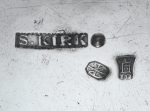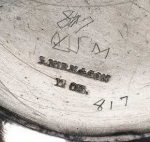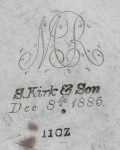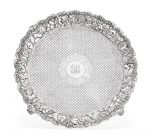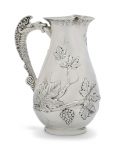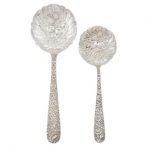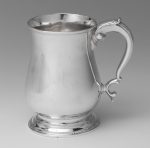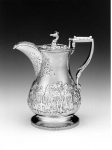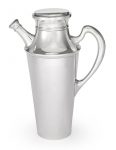Samuel Kirk & Son was founded in 1815 when Philadelphia-trained Samuel Kirk finished his apprenticeship under James Howell and moved to Baltimore. Attracted by the prosperous port, Kirk opened his shop at 212 Market Street (later known as 106 Baltimore Street) with fellow silversmith, John Smith. After the partnership was dissolved in 1821, Samuel Kirk carried on the business alone until his eldest son, Henry Child Kirk, became a partner in 1846.
S Kirk Silver Makers Mark with two assay office marks circa 1830
S Kirk Silver Makers Mark 1830 – 1846 found on coin silver
S Kirk & Sons Silver Makers Mark found on coin silver, circa mid 19th century
S Kirk Son Silver Makers Mark circa 1870
S Kirk & Son silver makers mark circa 1886
S Kirk & Son Silver Makers Mark circa 1925
Baltimore’s prominent silver manufacturing company, Samuel Kirk & Son, dates its beginning to 1815 when Philadelphia-trained Samuel Kirk finished his apprenticeship under James Howell and moved to Baltimore. Attracted by the prosperous port, Kirk opened his shop at 212 Market Street (later known as 106 Baltimore Street) with fellow silversmith, John Smith. After the partnership was dissolved in 1821, Samuel Kirk carried on the business alone until his eldest son, Henry Child Kirk, became a partner in 1846.
Sold for US$ 562 (£ 433) inc. premium at Bonhams in 2017
AN AMERICAN SILVER PITCHER MARK OF KIRK & SON, BALTIMORE, MARYLAND, 1846-1861 Of baluster form with shaped upper rim, chased overall with scrolling grapevine and grape bunches, the front engraved with script monogram EHF, the handle formed as a Celtic beast, marked on underside 7 ¾ in. (19.6 cm.) 19 oz. 4 dwt. (597 gr.)
Sold for USD 2,000 at Christies in 2019
Two S. Kirk & Son Sterling Silver Serving Spoons with Fruit and Floral Decoration Length of larger 9 1/8 inches, length of smaller 7 1/2 inches, total approximately 6 ounces.
Sold for $312 (includes buyer’s premium) at Doyle New York in 2018
Silver Cann made by S Kirk Made in Baltimore, Maryland, United States circa 1830
Pitcher 1830–46 Samuel Kirk (American, 1793–1872)
This pitcher has a seamed bulbous body with inset base. A deep V-spout with foliate decoration is set into the neck. Repousséd and chased landscapes and flowers surround the lower body. The flat conforming cover follows the upward curve of the spout and features repousséd and chased floral ornament. The cover is hinged to the top of the seamed, angular handle, which is decorated with applied stylized leaf grips and banded near the upper and lower joinings. A jaunty-eared greyhound-head finial perches above a scene of a boy wandering under weeping willows near cottages, a brook, and a stone bridge. The opposite side of the body features buildings with Gothic arches and towers, some in ruins, that line the water’s edge. Curving acanthus leaves soften the seam joining the deep inset spout to the upper portion of the vessel. The finial is attached with a bolt and screw. The raised foot splays outward, and a repeating stamped decoration appears at the join with the foot ring. The pitcher was formerly catalogued as a chocolate pot.
Samuel Kirk was perhaps the earliest American exponent of Europe’s new rage for the revival of the eighteenth-century Rococo style. From the beginning of his career, Kirk employed the technique of repousséd and chased foliate decoration characteristic of Rococo metalwork. Although some highly polished, plain surfaces remain on this pitcher, which was made early in Kirk’s career, ornament frequently covered the entire surface of his wares, which was known as “Baltimore-style” repoussé work
Kirk’s depictions of quaint country buildings and bridges, ruins of Gothic architecture, and children wandering through landscapes under trees and alongside brooks, as seen here, are derived from the romanticism of the mid-eighteenth century that found favor in Europe and America a century later. Sometimes referred to today as the “landscape” pattern, Kirk called it “Etruscan.”1 The wide traylike foot offers stability and adds to the decorative effect. Its flat polished surface and distinctive rippled edge reflect the shining brook pictured just above.
Reference: Museum of Fine Arts Boston
An American silver cocktail shaker, S. Kirk & Son Inc., Baltimore, 1925-32 monogrammed V marked on bases height 11 1/4 in. 28.5 cm 28 oz 871 g
Sold for 1,000 USD at Sothebys in 2018
